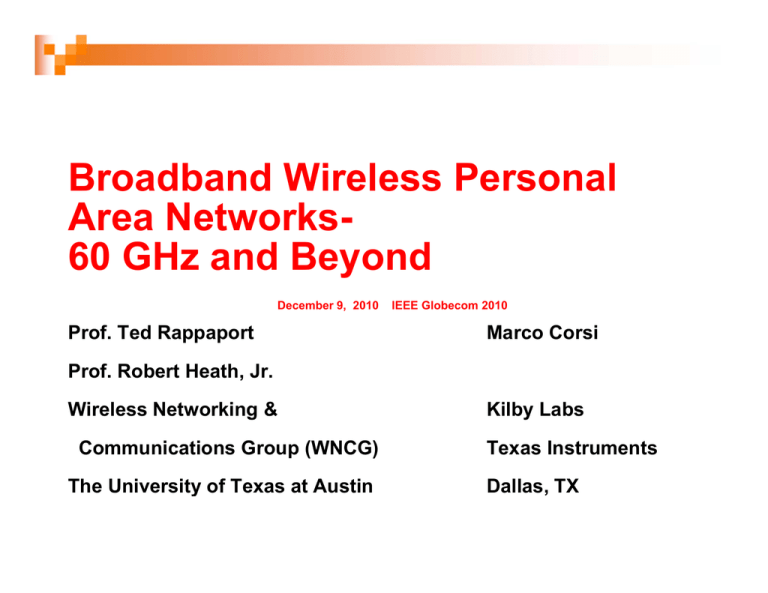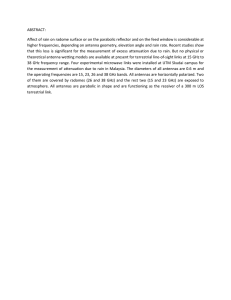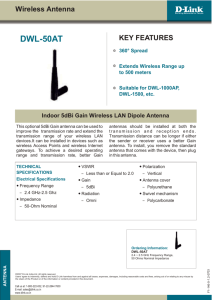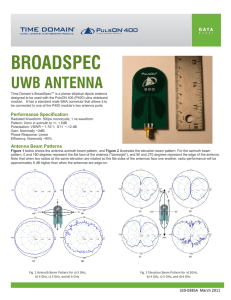Broadband Wireless Personal Area Networks
advertisement

Broadband Wireless Personal Area Networks60 GHz and Beyond December 9, 2010 Prof. Ted Rappaport IEEE Globecom 2010 Marco Corsi Prof. Robert Heath, Jr. Wireless Networking & Communications Group (WNCG) The University of Texas at Austin Kilby Labs Texas Instruments Dallas, TX 1 December 2010 mm-Wave and sub-mm-Wave THz Propagation • 60 GHz, 120 GHz, 183 GHz, 325 GHz, and 380 GHz for shorterrange applications • World-wide governmental agreement on 60 GHz! • 100 GHz and 240 GHz for longer-range applications Wells, J., "Faster than fiber: The future of multi-G/s wireless,"Microwave Magazine, IEEE, vol.10, no.3, pp.104-112, May 2009. 2 mm-Wave and sub-mm-Wave Orders of Magnitude More Spectrum AM Radio TV Broadcast FM Radio Cellular Wi-Fi Shaded Areas = Equivalent Spectrum! 60GHz Spectrum 77GHz Vehicular Radar Active mm-Wave CMOS IC Research 3 mm-Wave & sub-mm-Wave Short Range Applications • 60 GHz band products ready for release: TV set top boxes available soon • Applications: Information Showers, Wireless Interconnects, magnetic media & hard-drive replacement Information Showers Inexpensive Ubiquitous Integrated Transceivers 4 mm-Wave Long Range Applications • Tremendous data rate growth for cellular systems • 10 % of 2.85 Billion users w/data in 2007 → Growing Exponentially • Wireless mm-Wave and sub-mm-wave backhaul Required! • 60 GHz backhaul already in limited use • Highly directional antennas Buddhikot, M.M.; , "Cognitive Radio, DSA and Self-X: Towards Next Transformation in Cellular Networks (Extended Abstract)," New Frontiers in Dynamic Spectrum, 2010 IEEE Symposium on , vol., no., pp.1-5, 6-9 April 2010 5 Properties at THz Frequency Range Terahertz region – 0.3-10THz But loosely – 100GHz and upwards Wavelengths 3 mm to 30 m ? Properties • Behaves partly as light - Can be focused with a lens • Behaves partly as Radio Frequency waves for propagation – we can use antennas and metal structures for radiation and guidance at these frequencies • Thought to be Non-ionizing (health wise safer) Material Properties • Good penetration cloth, wood, concrete, plastics, paper • Absorbed heavily by water in various frequency bands within the THz range • Reflected by metals • A lot of naturally occurring compounds have resonances and interactions in this regime Application Space & Requirements Application Description Signal Structure Transceiver Requirement Security Sub-surface Imaging, Concealed explosives, weapons, drug inspection Pulsed, FMCW, CW Variable angle/Fixed angle Medical Imaging, monitoring, Early detection Pulsed, FMCW, CW Variable angle/Fixed angle Non-destructive testing Material Inspection, Structural integrity, Aviation and others CW (Mostly) Fixed angle/ Variable angle Amplitude detection Spectroscopy Chemical identification CW, Stepped Frequency Fixed angle, Amplitude Detection Wide tuning range Communication Mobile/Notebook docking (Terabit file transfers, HD stereo displays) Wireless Backhaul (2040Gbpsec links) CW – simple modulation Very High Gain Rx and Tx antenna Electronic Beam Steering for simple link establishment Spectroscopy Applications: Accurate recognition to few part-per-trillion for many gases. Abundant &unique “absorption” spectral lines in the 100-600GHz range. Slide from: Prof. Frank C. De Lucia, Ohio State University, AMERDEC, 2006: http://www.physics.ohio-state.edu/~uwave/2008site/Resources/talks%20without%20notes%20ppt%20files/HOE.HVL.1.19.06.ppt 8 Spectroscopy Demonstration: Expensive setup From Dr. Frank W. Patten DARPA-ATO-2005 Public released Proposer Day Conf. 2005 presentation. Or http://www.schafertmd.com/conference/PACT/downloads/Reiss-Smart-Transitions-PACT-Proposers-Day.pdf Imaging: Already Many applications Demonstrated.. Expensive Equipment. Imaging uses the Reflection property of THz waves: Applications in Medical and Security How do you look at THz images? http://teraview.com/terahertz/id/34 Terahertz in skin cancer TeraView has worked with clinical collaborators to establish the ability of terahertz to distinguish between basal cell carcinoma and other forms of malignant, benign and healthy tissue associated with skin cancer and related diseases. Both extensive ex vivo measurements for tissue classification and histopathological use, and preliminary in vivo measurements directly on patients have been successfully performed. Slide from: Prof. Frank C. De Lucia, Ohio State University, AMERDEC, 2006: http://www.physics.ohiostate.edu/~uwave/2008site/Resources/talks%20without%20notes%20ppt%20files /HOE.HVL.1.19.06.ppt 10 Mobile Application: 20+Gbpsec wireless “docking”! Today:0.5Gbpsec 1-4years: 5Gbpsec 5-10yrs: 20+Gbpsec Stereo 4K Movie: 2(3D)*4096*2160* 60 Frames * 24bit =25.5Gbpsec!! Broadcast DTV/FM/HDR/DRB 110Mbps 100Km Cellular Connectivity Modems 3G 4G 10 100Mb/sec 0.1 to 10Km Networks BT, WiFi, BAN .1 10Gbps 1m to 100m Heterogeneous Multi-processor Interconnect fabric 100Gbps Terabit/sec Applications processor Local content Video capture DRAM/NV Memory Image/Video/Gesture/HDI Image sharing – 3D 10’s100’s Gbps 1cm .22 Terabytes 2X 1080p60, 10 mins .5 3 Terabytes 2X QSXGA, 10 mins External displays Bandwidth increases by 10~100X Seamless adaptive connectivity? From G. Delagi ISSCC-2010 Plenary Presentation Telecommunication: Wireless THz links for Femtocell wireless back haul Network (Courtesy: David Britz AT&T , 2009) Femtocell Needs: 1- High Antenna Gain/Directivity for Point to Point Gbpsec link 2- Low Cost 3- Power efficient Courtesy: David Britz: dbritz@research.att.com AT&T Labs Research – Shannon Laboratories Broadband Wireless Personal Area Networks60 GHz and Beyond Semiconductor viewpoint: Path to low cost manufacturability Marco Corsi, Texas Instruments Fellow Kilby Labs December 9, 2010 13 Sub-mmwave electronics today. Active devices really do not have power gain. Circuitry built with multipliers and harmonic mixers that have inherent power loss. Several suppliers of instrumentation and equipment exist namely Virginia Diodes and OML. Device and material characterization can be done with turnkey Instrumentation purchased from these suppliers and a few others. VNAs now available to 1THz with 2THz on the horizon. A 140-220GHz VNA is now Less than $300k and this was > $700k less than a year ago. The instrumentation is Now more accessible than ever. Current sub-mm electronics looks like traditional microwave design did 20 years ago. Just smaller. 14 Can nm CMOS provide the power gain @ 300GHz? Fmax is the frequency beyond which it is not possible to have power gain above unity using a single MOS device for a given process. It is also the maximum freq. of oscillation using a single device and is a figure of Merit that is most relevant to Tx and Rx chain design. We need “Power Gain” > 1 to transmit, or to Receive in a lossy channel. Fmax is Sensitivity to process parameters: as gm, 1/Cgd, 1/Cgs, 1/Rg all improve with Process node shrink: effective Lg and Cgd, Cds reduce with lithography, Idrive(channel mobility using stress techniques) go up hence gm goes up, use of HiK dielectrics make effective Tox go down hence gm goes up and metal gate makes Rg go down Adapted from U. Gogineni, J. del Alamo, et al., (MIT), GRC review 10/2009 Sensitivity of fT and fmax Lg tox Hi K f T g 2 C C m gs gd Channel stress Highly layout dependent; do not scale well f f 8R C T max g gd ITRS 2009 Roadmap for Fmax vs Process @2015 Fmax crosses 600GHz Pwr Gain of 2 at 300GHz S. Sankaran et. al. ISSCC 2009, paper 11.4 Copper Interconnect is norm 16 Big Picture – Goal for Semiconductor Manufacturer Lab setups Teraview Current methods – Expensive – Not end-user friendly – Requires • Large space (big lasers, spectrometers, etc) • Or exotic/special meta-materials – Need lots of power • Goal – THz devices that are small and compact to fit in a typical 5x5mm2 15*15mm2 package for cost effective consumer apps – Few $ to 10’s of $$ to enable high volume markets. – Since gain is hard to achieve at THz, we rely on • Antenna arrays to produce gain • Accurate modeling of the devices at these frequencies to extract the maximum possible power out of the process • Coherent CW THz source • On-chip Phased Antenna Array • On-chip sub-mm integrated TX/RX Link Range Calculation at 300GHz Array Transceivers >20Gbpsec link R max Transmitted Power per antenna Transmit Antenna Element Gain (Patch antenna) Transmit Antenna Array Power Gain (Array=4 x 4 elements) Receive Antenna Element Gain (Patch antenna) Recieve Antenna Array Power Gain (Array=4 x 4 elements) Carrier Wavelength in Air (Carrier Frequency = 300GHz) Pt G t G r 2 4 3 kTB n F L d SNR R max Maximum Pt Tot . Power Radiated G t Transmit G r Receive antenna antenna Carrier wa F Receiver (m ) (W ) gain ( dBi ) gain ( dBi ) ( J/ o K ) ( Hz ) Noise Figure L d Atmospheri c Attenuatio SNR SNR expected n ( Loss/km at the receive “Mobile docking soln.” Transmitted Power per antenna Transmit Antenna Element Gain (Patch antenna) Transmit Antenna Array Power Gain (Array=32 x 32 elements) Receive Antenna Element Gain (Patch antenna) Recieve Antenna Array Power Gain (Array=32 x 32) elements) Carrier Wavelength in Air (Carrier Frequency = 300GHz) rature ( o K ) Bandwidth Incoming Noise Energy (kT @ 290K) ~1W Rx or Tx, $ Receiver Bandwidth Chip Size: <10mm2 Receiver Noise Figure Atmospheric Attenuation (10dB/km @25mm/hr rain) SNR at receiver detector Maximum Range (m ) s constant T Mean tempe Range from Antenna velength k Boltzmann' B n Signal Reception 1 9 12.0 9 12.0 0.001 mW dBi dB dBi dB m 4.00E-21 5 10 0.22 9 J GHz dB dB dB 2.21 m 1 9 30.1 9 30.1 0.001 mW dBi dB dBi dB m 4.00E-21 5 10 1.25 9 J GHz dB dB dB ) detector Incoming Noise Energy (kT @ 290K) ~50W Rx or Tx, $$$ Receiver Bandwidth Chip Size: <280mm2 Receiver Noise Figure Atmospheric Attenuation (10dB/km @25mm/hr rain) SNR at receiver detector Maximum Range “Femto-cell wireless backhaul” 125.37 m Why is directivity needed (Beyond Range)? From: Siliconization of 60 GHz, Ali. M. Niknejad High Directive Tx and Rx antennas result in: Much Lower Delay spread for multi-path Sub nsec (horn; G=25db) vs >10nsec Much lower Freq. fading dips in freq over the wide band channel No need for equalization (e.g DFE) Hundreds of FIR taps needed No need for OFDM modulation expensive for 5GHz+ BW Lower Blocker level at Rx Easier FE design/Linearity req. Arrays are a key for Sub-THz communication Electronically Steerable beams allow Locking Rx to Tx antenna beams simplifying deployment. 19 Typical Array Transceiver PA: > 500mVpp for > 1mW of radiated power Pwr-gain/stage >> 1 @300GHz Fmax >> 300GHz LNA: NF< 10 Pwr-gain/stage >> 1 Fmax >> 300GHz DAC ADC DAC ADC Phase CTRL Phase CTRL PLL LNA Phase Shifter: Need < ~10deg or <~0.1psec ctl Phase CTRL Phase CTRL DAC ADC DAC ADC BB PHY MAC 20Gbpsec SerDes For Power Efficiency of the Transceiver, you want the Mixer (freq. translation) right after least # gain stages from 1st LNA MOS passive Mixer Noise Figure is also very critical and also improves with higher Fmax, and lower Cgs 20 Schottky diodes on CMOS-New component – No mask adder Schottky diode area is separated by polysilicon gate on gate oxide layer. • The resistance of silicon region surrounded by STI becomes dominant. S. Sankaran et. al. ISSCC 2009 & Kenneth. K. O, UTD , private communication Cutoff frequency : 1~ 2THz f cutoff 1 2RC0 45nm TI CMOS process THz Signal Source 410GHz 390m 640m Ant radiation pattern 205GHz Freq: 410GHz : 0.75mm (air) Patch (Pad layer) Ground (M1-M5) Slot (2 m wide) W (200 m) Z X Y L (200 m) E. Y. Seok et al., “410-GHz CMOS Push-push Oscillator with a Patch Antenna,” 2008 International Solid-State Circuits Conference, pp. 472-473, Feb. 2008, San Francisco, CA. Silicon Substrate 22 Radiating edges Can we tightly control phase on CMOS? Digital Controlled Artificial Dielectrics Work Done at UCLA D. Huang (now at TI) 23 Steps of 5 deg at 60GHz = 0.23psec Fine control of array delay possible 24 How do we get radiation efficiency from Silicon? Combine Silicon with Package technology for a complete solution. Advanced Package technology allows < 100um pitches for routing Enabling working on 1mm Wavelength traces. Moves Radiating element farther out from ground plane improving Radiation efficiency > 80% of power radiated possible. Ali Hajimiri, mm-Wave Silicon ICs: Challenges and Opportunities, CICC 2007 3-10um Metal Stack Array 100 250um Heat Sink 50 -200um Si Si 25 Broadband Wireless Personal Area Networks60 GHz and Beyond PHY and MAC Challenges Prof. Robert W. Heath Jr. The University of Texas at Austin Wireless Networking and Communications Group December 2010 PHY, MAC, and Circuits MAC • 60GHz makes different tradeoffs between circuits, algorithms, and protocols compared with microwave systems PHY Algorithms – Circuits play a more substantial role – Digital signal processing is more challenging due to ADC and processing requirements PHY Circuits C 60 GHz Indoor Channel Properties 1 • Path loss exponent between 1.5 and 2.5 • Attenuation higher in most materials – Signal more isolated in rooms (better reuse) – Multi-room coverage may require repeaters or multi-hop (complex MAC) C. R. Anderson and T. S. Rappaport, “RF Propagation Characteristics at 2.5 GHz and 60 GHz.“ 2002-2004.nd characteristics of 60-GHz in 3, pp. 620-630, 2002. temporal 60 GHz Indoor Channel Properties 2 30 degree angle spread Different path lengths create multi-path interference 4 clusters • Delay spread: 3ns (LOS) to 15 ns (NLOS) – Need to equalize 5 to 60 taps of multi-path! • Multipath scattering clusters: 2 to 11 – Beam diversity may be possible • Angle spread anywhere from 8 to 120 degrees – Spatial diversity is available, MIMO may be possible H. Xu, V. Kukshya, and T. S. Rappaport, “Spatial and temporal characteristics of 60-GHz indoor channels,” IEEE Trans. on Sel. Areas in Commun. Vol. 20, no. 3, pp. 620-630, 2002. Human movement Attenuation (dB) 60 GHz Indoor Channel Properties 3 • Delay spread: 3ns (LOS) to 15 ns (NLOS) – Need to equalize 5 to 60 taps of multi-path! • Multipath scattering clusters: 2 to 11 – Beam diversity may be possible • Angle spread anywhere from 8 to 120 degrees – Spatial diversity is available, MIMO may be possible S. Collonge, G. Zaharia, and G.E. Zein, "Influence of the human activity on wide-band characteristics of the 60 GHz indoor radio channel," IEEE Transactions on Wireless Communications, Nov. 2004. No human movement PHY Modulations Modulation Advantages Disadvantages Constant Envelope Low PAPR; operates with simpler RF components Low spectral efficiency; hard to equalize SC-FDE Requires lower precision ADCs; lower PAPR; can operate with little or no coding IFFT/FFT both at receiver (asymmetry); cannot capture frequency diversity as well OFDM Best spectral efficiency; offers best potential for interference handling Requires linear PA, backoff; requires robust FEC; sensitive to phase noise Accommodating Video via PHY MSBs Heavy Coding LSBs Skewed constellations Multiplex ...011001 Source Splitting Unequal error protection Light Coding Q I Modulate Spreading at the PHY L source bandwidth spreading sequence • Beamforming often not available • Control channels, omni antennas, etc. • Sacrifice spectral efficiency to maintain link • May have L <= 64 symbol bandwidth MAC WPAN Concept control connections in piconet data connections in piconet Master Master Ad hoc access through piconets Slave Slave Slave Slave Surround Sound (Slave) Protocol for neighbor discovery, master election, resource allocation, and network maintenance must be provided by WPAN standard. Surround Sound (Slave) HDTV (Slave) Set-top Box (Master) Multi-media example Cable/Satellite (Slave) Blue Ray (Slave) Remote Control (Slave) Directional Antennas C A A talking to B C does not hear A Called deafness • Directional antennas are important for 60GHz – – – – Provides array gain to reduce link margin Multi-beam diversity for LOS outages Reduces extent of multi-path (less equalization) Large arrays possible c/o small wavelength • Directional antennas complicate MAC protocol B Directional Antennas MAC Quasi-Omni Sector Beam Hi-res Beam • Link setup may be performed via omni pattern • Training and feedback for beam selection, feedback, and tracking 36 36 60 GHz Current mm-Wave Standards Name Forum Type Status WirelessHD Industry Consortium International Standard Spec. 1.0, Jan 2008 Draft 1.0, Dec 2008 ECMA‐387 802.15.3c (TG3c) International Released Standard October 2009* 802.11ad (TGad) International Target Standard completion Dec 2012 WiGig Industry Consortium Released May 2010* Maximum Data Rate (Gbps) Applications OFDM SC (Single Carrier) 4 _ Uncompressed HD video 4.032 6.35 Bulk data transfer and HD streaming 5.7 5.2 Portable point‐to‐point file transfer and streaming Rapid upload/download, wireless display, distribution of HDTV >1 7 Gpbs* File transfers, wireless display and docking, and streaming high definition Singh, H.; Su-Khiong Yong; Jisung Oh; Chiu Ngo; , "Principles of IEEE 802.15.3c: Multi-Gigabit Millimeter-Wave Wireless PAN," Computer Communications and Networks, 2009. ICCCN 2009. Proceedings of 18th Internatonal Conference on , vol., no., pp.1-6, 3-6 Aug. 2009 “WiGig Alliance Publishes Multi-Gigabit Wireless Specification and Launches Adopter Program,” WiGig press release, Retrieved July 4, 2010, from 37




